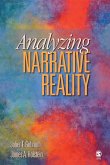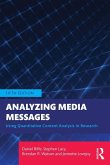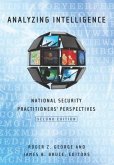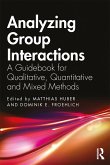Analyzing and Interpreting Qualitative Research
After the Interview
Herausgeber: Vanover, Charles F.; Mihas, Paul A.; Saldana, Johnny
Analyzing and Interpreting Qualitative Research
After the Interview
Herausgeber: Vanover, Charles F.; Mihas, Paul A.; Saldana, Johnny
- Broschiertes Buch
- Merkliste
- Auf die Merkliste
- Bewerten Bewerten
- Teilen
- Produkt teilen
- Produkterinnerung
- Produkterinnerung
Drawing on the expertise of major names in the field, this text provides comprehensive coverage of the key methods for analyzing, interpreting, and writing up qualitative research in a single volume.
Andere Kunden interessierten sich auch für
![Collecting and Interpreting Qualitative Materials Collecting and Interpreting Qualitative Materials]() Norman K. DenzinCollecting and Interpreting Qualitative Materials123,99 €
Norman K. DenzinCollecting and Interpreting Qualitative Materials123,99 €![Analyzing Textual Information Analyzing Textual Information]() Johannes LedolterAnalyzing Textual Information48,99 €
Johannes LedolterAnalyzing Textual Information48,99 €![Analyzing Narrative Reality Analyzing Narrative Reality]() Jaber F. GubriumAnalyzing Narrative Reality89,99 €
Jaber F. GubriumAnalyzing Narrative Reality89,99 €![Analyzing Media Messages Analyzing Media Messages]() Daniel RiffeAnalyzing Media Messages46,99 €
Daniel RiffeAnalyzing Media Messages46,99 €![Analyzing Media Messages Analyzing Media Messages]() Daniel RiffeAnalyzing Media Messages152,99 €
Daniel RiffeAnalyzing Media Messages152,99 €![Analyzing Intelligence Analyzing Intelligence]() Analyzing Intelligence47,99 €
Analyzing Intelligence47,99 €![Analyzing Group Interactions Analyzing Group Interactions]() Analyzing Group Interactions46,99 €
Analyzing Group Interactions46,99 €-
-
-
Drawing on the expertise of major names in the field, this text provides comprehensive coverage of the key methods for analyzing, interpreting, and writing up qualitative research in a single volume.
Produktdetails
- Produktdetails
- Verlag: SAGE Publications Inc
- Seitenzahl: 504
- Erscheinungstermin: 30. Juni 2021
- Englisch
- Abmessung: 229mm x 182mm x 30mm
- Gewicht: 936g
- ISBN-13: 9781544395876
- ISBN-10: 1544395876
- Artikelnr.: 60618450
- Herstellerkennzeichnung
- Libri GmbH
- Europaallee 1
- 36244 Bad Hersfeld
- gpsr@libri.de
- Verlag: SAGE Publications Inc
- Seitenzahl: 504
- Erscheinungstermin: 30. Juni 2021
- Englisch
- Abmessung: 229mm x 182mm x 30mm
- Gewicht: 936g
- ISBN-13: 9781544395876
- ISBN-10: 1544395876
- Artikelnr.: 60618450
- Herstellerkennzeichnung
- Libri GmbH
- Europaallee 1
- 36244 Bad Hersfeld
- gpsr@libri.de
Charles Vanover is an associate professor at the University of South Florida. He is the author of "Chalkboard Concerto," "Teaching the Power of the Word," and the five ethnodramas in his Inquiry Theatre Series. Paul Mihas is the Assistant Director of Education and Qualitative Research at the Odum Institute for Research in Social Science at the University of North Carolina at Chapel Hill. He is the former managing editor of Social Forces, a journal of sociology published at the University of North Carolina Press. He teaches regularly through the ICPSR Summer Program in Quantitative Methods of Social Research and the Global School of Empirical Research Methods at the University of St. Gallen, the Norwegian Business School, and the University of Ljubljana Faculty of Economics. As a qualitative analysis consultant with ResearchTalk, he serves as faculty at the annual Qualitative Research Summer Intensive and a mentor at ResearchTalk's Qualitative Data Analysis Camps. Mihas is a co-author on Ray Maietta's Sort and Sift, Think and Shift (forthcoming). Johnny Saldaña is Professor Emeritus from Arizona State University's (ASU) School of Film, Dance, and Theatre in the Herberger Institute for Design and the Arts, where he taught from 1981 to 2014. He received his BFA in Drama and English Education in 1976, and MFA in Drama Education in 1979 from the University of Texas at Austin. Saldaña is the author of Longitudinal Qualitative Research: Analyzing Change through Time (AltaMira Press, 2003); Fundamentals of Qualitative Research (Oxford University Press, 2011); Ethnotheatre: Research from Page to Stage (Left Coast Press, 2011); Thinking Qualitatively: Methods of Mind (Sage Publications, 2015); a commissioned title for Routledge's World Library of Educationalists Series, Writing Qualitatively: The Selected Works of Johnny Saldaña (Routledge, 2018); co-author with the late Matthew B. Miles and A. Michael Huberman for Qualitative Data Analysis: A Methods Sourcebook (4th ed., Sage Publications, 2020); co-author with Matt Omasta for Qualitative Research: Analyzing Life (Sage Publications, 2018); and the editor of Ethnodrama: An Anthology of Reality Theatre (AltaMira Press, 2005). Previous editions of The Coding Manual for Qualitative Researchers have been translated into Korean, Turkish, and Chinese-Simplified. Saldaña's methods works have been cited and referenced in more than 16,000 research studies conducted in over 130 countries in disciplines such as K-12 and higher education, medicine and health care, technology and social media, business and economics, government and social services, the fine arts, the social sciences, human development, and communication. He has published a wide range of research articles in journals such as Research in Drama Education, The Qualitative Report, Multicultural Perspectives, Youth Theatre Journal, Journal of Curriculum and Pedagogy, Teaching Theatre, Research Studies in Music Education, Cultural Studies ? Critical Methodologies, the International Journal of Qualitative Methods, the International Review of Qualitative Research, and Qualitative Inquiry, and has contributed several chapters to research methods handbooks. His most popular journal article, "Blue-Collar Qualitative Research: A Rant" ( Qualitative Inquiry, 2014), has been downloaded by over 3,000 readers, according to ResearchGate. Saldaña's research in qualitative inquiry, data analysis, and performance ethnography has received awards from the American Alliance for Theatre & Education, the National Communication Association-Ethnography Division, the American Educational Research Association's Qualitative Research Special Interest Group, New York University's Program in Educational Theatre, the Children's Theatre Foundation of America, and the ASU Herberger Institute for Design and the Arts.
Introduction - Charles Vanover, Paul Mihas, and Johnny Saldaña
SECTION 1: DATA AND CONCEPTUAL OPTIONS - Charles Vanover and Paul Mihas
Chapter 1: As A Qualitative Study Unfolds: Shifts in Design and Analysis -
Gerardo L. Blanco & Gretchen B. Rossman
Chapter 2: Using Qualitative Data Analysis Software to Manage the Research
Process - Jessica N. Lester & Trena M. Paulus
Chapter 3: After Someone Else's Interview - Sheryl L. Chatfield
SECTION 2: INTERVIEW TRANSCRIPTION STRATEGIES - Charles Vanover
Chapter 4: Transcription as a Form of Qualitative Inquiry - Charles Vanover
Chapter 5: Theories and Practices of Transcription from Discourse Analysis
- Mariaelena Bartesaghi
Chapter 6: Voice to Text: Automating Transcription - Silvana di Gregorio
SECTION 3: STRATEGIES FOR CODING AND CATEGORIZING DATA - Paul Mihas
Chapter 7: Coding System Design and Management - Daniel Turner
Chapter 8: Deductive and Inductive Approaches to Qualitative Data Analysis
- Andrea J. Bingham & Patricia Witkowsky
Chapter 9: Coding, Categorizing, and Theming the Data: A Reflexive Search
for Meaning - Janet C. Richards
Chapter 10: Oral Coding: An Alternative Way to Make Sense of Interview Data
- James A. Bernauer
Chapter 11: Mapping Trajectories: Analyzing and Interpreting Focus Group
Data Rhizomatically - Alyson Welker & George Kamberelis
Chapter 12: Analyzing and Coding Interviews and Focus Groups Considering
Cross-Cultural and Cross-Language Data - Elsa M. Gonzalez and Yvonna S.
Lincoln
SECTION 4: REFLECTION AND ANALYTIC MEMOING STRATEGIES - Paul Mihas
Chapter 13: On Being a Researcher-Participant: Challenges With the
Iterative Process of Data Production, Analysis and (Re)Production - Craig
M. McGill, Drew Puroway, and Mark Duslak
Chapter 14: Memo Writing Strategies: Analyzing the Parts and the Whole -
Paul Mihas
Chapter 15: Critical Analytic Memoing - Elaine Keane
SECTION 5: INTERPRETIVE STRATEGIES - Paul Mihas
Chapter 16: Listening Deeply: Indexing Research Conversations - Jaime L.
Fiddler
Chapter 17: Emergent Analysis: Strategies for Making Sense of an Evolving
Longitudinal Study - Adrian Larbi-Cherif, Cori Egan, Joshua L. Glazer
Chapter 18: Making Claims Using Qualitative Data - Tim Huffman
SECTION 6: ARTS-BASED PRACTICES - Johnny Saldaña
Chapter 19: Dramatizing Interviews - Johnny Saldaña
Chapter 20: What Makes an Effective Teacher? Revealing Good Teaching
Practice Through Poetic Transcription - Robyn Shenfield & Monica
Prendergast
Chapter 21: Embedding Critical, Creative, and Contemplative Data Analysis
in Interview Studies - Kakali Bhattacharya
Chapter 22: Follow the Headlights: On Comics-Based Data Analysis - Sally
Campbell Galman
SECTION 7: WRITING-UP PRACTICES - Paul Mihas
Chapter 23: Turning Transcripts into Stories - Aishath Nasheeda, Haslinda
Binti Abdullah, Steven Eric Krauss, Nobaya Binti Ahmed
Chapter 24: Writing for a Broad Audience: White Papers, Blogs, and OpEds -
Jessica Smartt Gullion
Chapter 25: Sophie's Choices: The Social Act of Publishing a Qualitative
Study - Mitchell Allen
Conclusion - Paul Mihas, Johnny Saldaña, and Charles Vanover
SECTION 1: DATA AND CONCEPTUAL OPTIONS - Charles Vanover and Paul Mihas
Chapter 1: As A Qualitative Study Unfolds: Shifts in Design and Analysis -
Gerardo L. Blanco & Gretchen B. Rossman
Chapter 2: Using Qualitative Data Analysis Software to Manage the Research
Process - Jessica N. Lester & Trena M. Paulus
Chapter 3: After Someone Else's Interview - Sheryl L. Chatfield
SECTION 2: INTERVIEW TRANSCRIPTION STRATEGIES - Charles Vanover
Chapter 4: Transcription as a Form of Qualitative Inquiry - Charles Vanover
Chapter 5: Theories and Practices of Transcription from Discourse Analysis
- Mariaelena Bartesaghi
Chapter 6: Voice to Text: Automating Transcription - Silvana di Gregorio
SECTION 3: STRATEGIES FOR CODING AND CATEGORIZING DATA - Paul Mihas
Chapter 7: Coding System Design and Management - Daniel Turner
Chapter 8: Deductive and Inductive Approaches to Qualitative Data Analysis
- Andrea J. Bingham & Patricia Witkowsky
Chapter 9: Coding, Categorizing, and Theming the Data: A Reflexive Search
for Meaning - Janet C. Richards
Chapter 10: Oral Coding: An Alternative Way to Make Sense of Interview Data
- James A. Bernauer
Chapter 11: Mapping Trajectories: Analyzing and Interpreting Focus Group
Data Rhizomatically - Alyson Welker & George Kamberelis
Chapter 12: Analyzing and Coding Interviews and Focus Groups Considering
Cross-Cultural and Cross-Language Data - Elsa M. Gonzalez and Yvonna S.
Lincoln
SECTION 4: REFLECTION AND ANALYTIC MEMOING STRATEGIES - Paul Mihas
Chapter 13: On Being a Researcher-Participant: Challenges With the
Iterative Process of Data Production, Analysis and (Re)Production - Craig
M. McGill, Drew Puroway, and Mark Duslak
Chapter 14: Memo Writing Strategies: Analyzing the Parts and the Whole -
Paul Mihas
Chapter 15: Critical Analytic Memoing - Elaine Keane
SECTION 5: INTERPRETIVE STRATEGIES - Paul Mihas
Chapter 16: Listening Deeply: Indexing Research Conversations - Jaime L.
Fiddler
Chapter 17: Emergent Analysis: Strategies for Making Sense of an Evolving
Longitudinal Study - Adrian Larbi-Cherif, Cori Egan, Joshua L. Glazer
Chapter 18: Making Claims Using Qualitative Data - Tim Huffman
SECTION 6: ARTS-BASED PRACTICES - Johnny Saldaña
Chapter 19: Dramatizing Interviews - Johnny Saldaña
Chapter 20: What Makes an Effective Teacher? Revealing Good Teaching
Practice Through Poetic Transcription - Robyn Shenfield & Monica
Prendergast
Chapter 21: Embedding Critical, Creative, and Contemplative Data Analysis
in Interview Studies - Kakali Bhattacharya
Chapter 22: Follow the Headlights: On Comics-Based Data Analysis - Sally
Campbell Galman
SECTION 7: WRITING-UP PRACTICES - Paul Mihas
Chapter 23: Turning Transcripts into Stories - Aishath Nasheeda, Haslinda
Binti Abdullah, Steven Eric Krauss, Nobaya Binti Ahmed
Chapter 24: Writing for a Broad Audience: White Papers, Blogs, and OpEds -
Jessica Smartt Gullion
Chapter 25: Sophie's Choices: The Social Act of Publishing a Qualitative
Study - Mitchell Allen
Conclusion - Paul Mihas, Johnny Saldaña, and Charles Vanover
Introduction - Charles Vanover, Paul Mihas, and Johnny Saldaña
SECTION 1: DATA AND CONCEPTUAL OPTIONS - Charles Vanover and Paul Mihas
Chapter 1: As A Qualitative Study Unfolds: Shifts in Design and Analysis -
Gerardo L. Blanco & Gretchen B. Rossman
Chapter 2: Using Qualitative Data Analysis Software to Manage the Research
Process - Jessica N. Lester & Trena M. Paulus
Chapter 3: After Someone Else's Interview - Sheryl L. Chatfield
SECTION 2: INTERVIEW TRANSCRIPTION STRATEGIES - Charles Vanover
Chapter 4: Transcription as a Form of Qualitative Inquiry - Charles Vanover
Chapter 5: Theories and Practices of Transcription from Discourse Analysis
- Mariaelena Bartesaghi
Chapter 6: Voice to Text: Automating Transcription - Silvana di Gregorio
SECTION 3: STRATEGIES FOR CODING AND CATEGORIZING DATA - Paul Mihas
Chapter 7: Coding System Design and Management - Daniel Turner
Chapter 8: Deductive and Inductive Approaches to Qualitative Data Analysis
- Andrea J. Bingham & Patricia Witkowsky
Chapter 9: Coding, Categorizing, and Theming the Data: A Reflexive Search
for Meaning - Janet C. Richards
Chapter 10: Oral Coding: An Alternative Way to Make Sense of Interview Data
- James A. Bernauer
Chapter 11: Mapping Trajectories: Analyzing and Interpreting Focus Group
Data Rhizomatically - Alyson Welker & George Kamberelis
Chapter 12: Analyzing and Coding Interviews and Focus Groups Considering
Cross-Cultural and Cross-Language Data - Elsa M. Gonzalez and Yvonna S.
Lincoln
SECTION 4: REFLECTION AND ANALYTIC MEMOING STRATEGIES - Paul Mihas
Chapter 13: On Being a Researcher-Participant: Challenges With the
Iterative Process of Data Production, Analysis and (Re)Production - Craig
M. McGill, Drew Puroway, and Mark Duslak
Chapter 14: Memo Writing Strategies: Analyzing the Parts and the Whole -
Paul Mihas
Chapter 15: Critical Analytic Memoing - Elaine Keane
SECTION 5: INTERPRETIVE STRATEGIES - Paul Mihas
Chapter 16: Listening Deeply: Indexing Research Conversations - Jaime L.
Fiddler
Chapter 17: Emergent Analysis: Strategies for Making Sense of an Evolving
Longitudinal Study - Adrian Larbi-Cherif, Cori Egan, Joshua L. Glazer
Chapter 18: Making Claims Using Qualitative Data - Tim Huffman
SECTION 6: ARTS-BASED PRACTICES - Johnny Saldaña
Chapter 19: Dramatizing Interviews - Johnny Saldaña
Chapter 20: What Makes an Effective Teacher? Revealing Good Teaching
Practice Through Poetic Transcription - Robyn Shenfield & Monica
Prendergast
Chapter 21: Embedding Critical, Creative, and Contemplative Data Analysis
in Interview Studies - Kakali Bhattacharya
Chapter 22: Follow the Headlights: On Comics-Based Data Analysis - Sally
Campbell Galman
SECTION 7: WRITING-UP PRACTICES - Paul Mihas
Chapter 23: Turning Transcripts into Stories - Aishath Nasheeda, Haslinda
Binti Abdullah, Steven Eric Krauss, Nobaya Binti Ahmed
Chapter 24: Writing for a Broad Audience: White Papers, Blogs, and OpEds -
Jessica Smartt Gullion
Chapter 25: Sophie's Choices: The Social Act of Publishing a Qualitative
Study - Mitchell Allen
Conclusion - Paul Mihas, Johnny Saldaña, and Charles Vanover
SECTION 1: DATA AND CONCEPTUAL OPTIONS - Charles Vanover and Paul Mihas
Chapter 1: As A Qualitative Study Unfolds: Shifts in Design and Analysis -
Gerardo L. Blanco & Gretchen B. Rossman
Chapter 2: Using Qualitative Data Analysis Software to Manage the Research
Process - Jessica N. Lester & Trena M. Paulus
Chapter 3: After Someone Else's Interview - Sheryl L. Chatfield
SECTION 2: INTERVIEW TRANSCRIPTION STRATEGIES - Charles Vanover
Chapter 4: Transcription as a Form of Qualitative Inquiry - Charles Vanover
Chapter 5: Theories and Practices of Transcription from Discourse Analysis
- Mariaelena Bartesaghi
Chapter 6: Voice to Text: Automating Transcription - Silvana di Gregorio
SECTION 3: STRATEGIES FOR CODING AND CATEGORIZING DATA - Paul Mihas
Chapter 7: Coding System Design and Management - Daniel Turner
Chapter 8: Deductive and Inductive Approaches to Qualitative Data Analysis
- Andrea J. Bingham & Patricia Witkowsky
Chapter 9: Coding, Categorizing, and Theming the Data: A Reflexive Search
for Meaning - Janet C. Richards
Chapter 10: Oral Coding: An Alternative Way to Make Sense of Interview Data
- James A. Bernauer
Chapter 11: Mapping Trajectories: Analyzing and Interpreting Focus Group
Data Rhizomatically - Alyson Welker & George Kamberelis
Chapter 12: Analyzing and Coding Interviews and Focus Groups Considering
Cross-Cultural and Cross-Language Data - Elsa M. Gonzalez and Yvonna S.
Lincoln
SECTION 4: REFLECTION AND ANALYTIC MEMOING STRATEGIES - Paul Mihas
Chapter 13: On Being a Researcher-Participant: Challenges With the
Iterative Process of Data Production, Analysis and (Re)Production - Craig
M. McGill, Drew Puroway, and Mark Duslak
Chapter 14: Memo Writing Strategies: Analyzing the Parts and the Whole -
Paul Mihas
Chapter 15: Critical Analytic Memoing - Elaine Keane
SECTION 5: INTERPRETIVE STRATEGIES - Paul Mihas
Chapter 16: Listening Deeply: Indexing Research Conversations - Jaime L.
Fiddler
Chapter 17: Emergent Analysis: Strategies for Making Sense of an Evolving
Longitudinal Study - Adrian Larbi-Cherif, Cori Egan, Joshua L. Glazer
Chapter 18: Making Claims Using Qualitative Data - Tim Huffman
SECTION 6: ARTS-BASED PRACTICES - Johnny Saldaña
Chapter 19: Dramatizing Interviews - Johnny Saldaña
Chapter 20: What Makes an Effective Teacher? Revealing Good Teaching
Practice Through Poetic Transcription - Robyn Shenfield & Monica
Prendergast
Chapter 21: Embedding Critical, Creative, and Contemplative Data Analysis
in Interview Studies - Kakali Bhattacharya
Chapter 22: Follow the Headlights: On Comics-Based Data Analysis - Sally
Campbell Galman
SECTION 7: WRITING-UP PRACTICES - Paul Mihas
Chapter 23: Turning Transcripts into Stories - Aishath Nasheeda, Haslinda
Binti Abdullah, Steven Eric Krauss, Nobaya Binti Ahmed
Chapter 24: Writing for a Broad Audience: White Papers, Blogs, and OpEds -
Jessica Smartt Gullion
Chapter 25: Sophie's Choices: The Social Act of Publishing a Qualitative
Study - Mitchell Allen
Conclusion - Paul Mihas, Johnny Saldaña, and Charles Vanover








